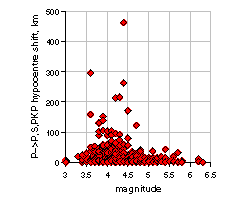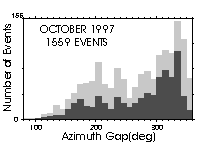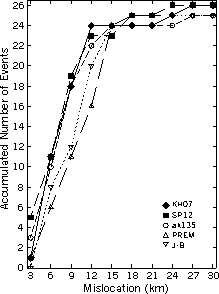PKP and S arrival times improve moderate size event locations.
Many types of phases associated with seismic events all over the world
are already published in the Bulletin, yet only the P times are used
for computing ISC hypocentres. Dmitry Storchak has investigated what
size earthquakes would have their locations changed most if the ISC
took more advantage of the wide variety of contributed phases.

Moderate
sized earthquakes (mb < 4.5) are shifted
more than larger events when additional phases are used, but
even some mb > 5.5 events move more than
30 km.
Using S and PKP arrival times to relocate events of one month
of the Bulletin shows that the most benefit comes from the use
of S arrivals at close distances and PKP arrivals at distances
near the caustic. Relocations using Jeffreys-Bullen travel times
for P at distances 0º-105º, S at 0º-8º and PKP at 140º-150º does
not result in a systematic shift of hypocentres. Uncertainties
in earthquake location generally improve, even though the
variance of travel time residuals rises slightly. The number of
events with the fixed depth diminishes, since more depths are
constrained by PKP times. The greatest location improvements
are found for mb < 4.5 events, since
epicentres of larger earthquakes are already well-constrained by
a sufficient number of P times.
|
Regional S arrival times help locate unconstrained events.
Due to poor station distribution the ISC fails to compute a depth or
even an epicentre for some earthquakes recorded by a good number of
stations. Mamy Andrianirina's study focused on these events, which
are troublesome because so many small earthquakes are recorded only at
stations in a limited range of azimuths. For an arbitrarily selected
month, he found that using secondary phase times, especially regional
phases such as Sg and Sn, can cut the number of events without an
ISC-computed location by more than half. With large azimuthal gaps,
an accurate travel time model remains essential to avoid biased
locations. Regardless of the model, however, reliable locations could
not be computed for many of these events from P times alone.

Events with no ISC location (pale grey) have large azimuthal
gap. With S times, however, ISC locations can be computed in
most cases (dark grey); the limit is availability of S times
rather than the distribution of stations.
For events where ISC was already able to compute a location from P
times, relocating the events using S times usually moved the
ISC-computed location closer to that reported by a local agency,
indicating better accuracy. In addition, formal uncertainties of ISC
locations were reduced with the addition of regional secondary phase
times.
Perhaps the most intriguing response to this work is that several
agencies have volunteered to begin contributing secondary phase times,
now that ISC plans to put them to good use. If so, it may be possible
to compute ISC locations for even more of these events.
|
Travel times from 3-D earth models reduce location bias.
Chen Qi-fu presented results from teleseismic location tests that
compared locations using spherically symmetric (JB, PREM, ak135) and
laterally heterogeneous models (SP12, KH07), and investigated the
effects of elevation and crustal thickness corrections.
Events were relocated with each model using ISC's standard procedures.
The algorithm is based on Geiger's method, but weights arrival times
iteratively and estimates location uncertainty from results of modern
robust regression. The 3-D models give statistically significant
improvement in locations over any of the 1-D models for globally
distributed ground-truth events, including 26 explosions studied by
Smith and Ekström and 82 earthquakes used by Kennett and Engdahl for
the IASP91 model. Nevertheless, tests excluding regional and local
data showed that with teleseismic data alone 3-D models are
insufficient to equal the accuracy achieved in the Bulletin.

Cumulative distributions of explosion epicentre errors for
several one- and three-dimensional earth models.
For a one-month set of all earthquakes that could be relocated without
manual editing, 3-D model KH07 improved residuals and location
uncertainty compared to those in the Bulletin. Further tests using
KH07 with selected South American events improved resolution of the
subduction zone (especially at h>100 km) compared with the Bulletin,
but not as well as Engdahl et al., who used depth phases.
|



